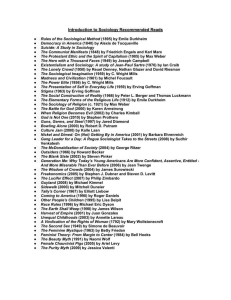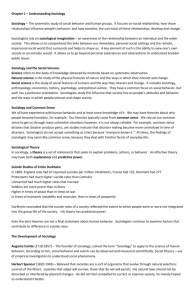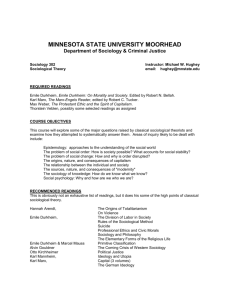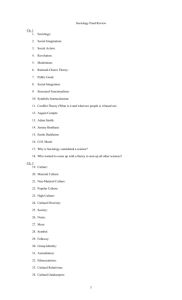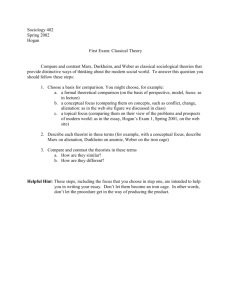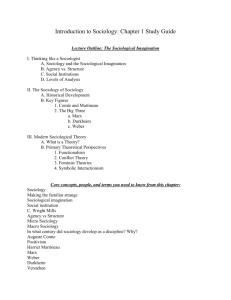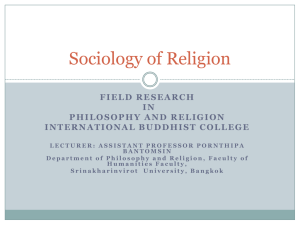What is sociology? - Midlands State University
advertisement
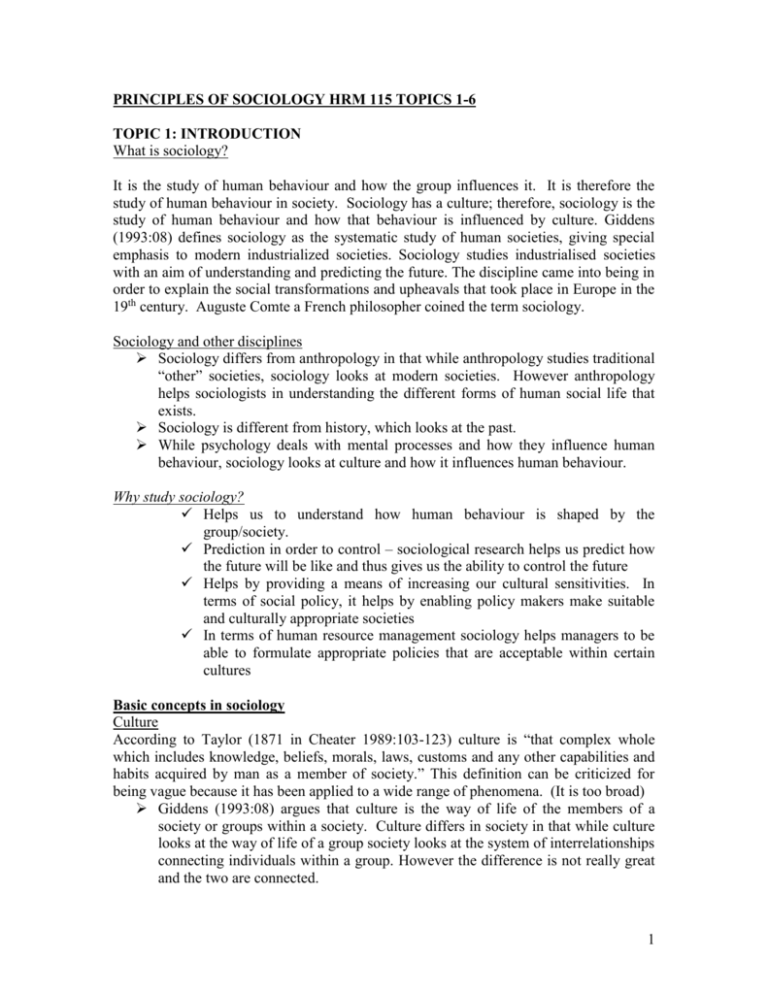
PRINCIPLES OF SOCIOLOGY HRM 115 TOPICS 1-6
TOPIC 1: INTRODUCTION
What is sociology?
It is the study of human behaviour and how the group influences it. It is therefore the
study of human behaviour in society. Sociology has a culture; therefore, sociology is the
study of human behaviour and how that behaviour is influenced by culture. Giddens
(1993:08) defines sociology as the systematic study of human societies, giving special
emphasis to modern industrialized societies. Sociology studies industrialised societies
with an aim of understanding and predicting the future. The discipline came into being in
order to explain the social transformations and upheavals that took place in Europe in the
19th century. Auguste Comte a French philosopher coined the term sociology.
Sociology and other disciplines
Sociology differs from anthropology in that while anthropology studies traditional
“other” societies, sociology looks at modern societies. However anthropology
helps sociologists in understanding the different forms of human social life that
exists.
Sociology is different from history, which looks at the past.
While psychology deals with mental processes and how they influence human
behaviour, sociology looks at culture and how it influences human behaviour.
Why study sociology?
Helps us to understand how human behaviour is shaped by the
group/society.
Prediction in order to control – sociological research helps us predict how
the future will be like and thus gives us the ability to control the future
Helps by providing a means of increasing our cultural sensitivities. In
terms of social policy, it helps by enabling policy makers make suitable
and culturally appropriate societies
In terms of human resource management sociology helps managers to be
able to formulate appropriate policies that are acceptable within certain
cultures
Basic concepts in sociology
Culture
According to Taylor (1871 in Cheater 1989:103-123) culture is “that complex whole
which includes knowledge, beliefs, morals, laws, customs and any other capabilities and
habits acquired by man as a member of society.” This definition can be criticized for
being vague because it has been applied to a wide range of phenomena. (It is too broad)
Giddens (1993:08) argues that culture is the way of life of the members of a
society or groups within a society. Culture differs in society in that while culture
looks at the way of life of a group society looks at the system of interrelationships
connecting individuals within a group. However the difference is not really great
and the two are connected.
1
Keesing (1974:80) defines culture as a set of shared meanings and values. Thus
culture can be viewed as a cognitive system where it consists of standards for
deciding what to do about it and for deciding how to go about doing it
Culture as a resource – culture can be liked to a super market where people pick and
choose the things they want. Thus people pick and choose the norms and values to use in
everyday life. Men and women use several aspects of culture either to attack others or
defend themselves.
Culture as an instrument of domination (Bourdieu 1984)
Maintains that culture plays a major role in maintaining social inequality. Based no their
social origins, individuals acquire capacities for interpreting and using culture codes that
affect their opportunities to maintain or change their social position. In a patriarchal
situation, it is culture that upholds the position of men over women. Cheater (1986:06)
goes on to argue that culture can be viewed as a set of ideological percepts that can be
mobilized into socio-political interacts.
Culture as a way of life
O’Connor and Downing (1995:03) highlight that culture is the essence of a people’s way
of life, e.g. how they dress, their marriage system, religion etc
Culture industries
These include newspapers, books, art, music who maintain/perpetuate a people’s way of
life.
The 3 symbols that constitute culture
Peterson (1979:137) argues that norms, values and beliefs are the symbols that constitute
culture.
a) Values – these are choice statements that rank behaviour or goals. They are
abstract ideals held by members of a given society.
b) Norms – these are more specific than values. They refer to the “dos” and “don’ts”
of social life. These are the rules governing social life which people are expected
to observe.
c) Beliefs – these are existential statements about how the world operates that often
serve to justify norms and values.
Culture therefore refers to the norms, values, beliefs, and material goods created by
people in society. Norms can be divided mores, fall ways, taboos etc
What is socialisation?
When children are born into society they are socialized into the way of life of that group.
Socialisation is a process of inculcating societies’ norms and values into an individual.
Socialisation takes place in two levels, that is, primary and secondary.
Primary socialisation – a process whereby an infant/child acquires the skills/ways of life
of a society into which he/she is born. It mainly takes place at home and is done by the
parents or family of the young child.
2
Secondary socialization – this happens in schools, workplaces, universities etc where
individuals continually learn to adjust to the demands of society.
Socialization is a life long process that starts from birth and end in the grave or death
Roles
As an individual is socialized into society’s norms and values, he/she learns to take a
role. Roles are socially defined expectations that a person in a given status or social
position follows. It is the duty one carries out whether at home, in the workplace or at
school. For example, my role is to lecture and yours is to be attentive students. Roles are
allocated to individuals by society. Where these roles become too many for an individual
they can cause role strain/role conflict/role confusion. For example, where one is a
student, father, brother, worker, husband, boyfriend, son and an uncle
Status
This refers to a position that one occupies in the society. It is linked to roles in that for
one to perform a certain role they have to occupy a certain social position. For example,
to be a teacher you have to occupy a certain position.
Topic 3:THE HISTORICAL DEVELOPMENT OF SOCIOLOGY
The discipline of sociology can be said to have developed as a result of the following
factors;
1. The enlightenment thinkers
2. Industrialization
3. Urbanization
4. Growth of communism
The enlightenment thinkers: Philosophical foundations
The general arguments pursued by enlightenment thinkers were:
1. Belief in empiricism – they believed that everything must be empirical, that is,
proved through experiments or other methods. It is through empiricism that
knowledge is increased. If one said the earth is spherical then one had to prove
their claim. Empiricism was an attempt to depart from explaining things using the
supernatural “eternal verities” to explain social reality using reason and science.
2. Papal infallibility – they rejected the view that the pope is infallible/does not sin
and argued that everyone responsible for his/her actions. They also rejected the
point that the new pope was appointed by God and argued that people had the
right elect presidents into office, that is, to remove and install governments into
office.
Rousseau and Montesquieu :the 2 thinkers we shall look at
Montesquieu (16988 – 1755)
In his book, Spirit of the laws, he sought laws social and historical development. He
argued that social institutes have an interdependent and correlative relationship to one
another and are dependant on the form of the whole. Therefore, the whole is greater than
the sum of its parts. Montesquieu studied forms of government such as the republic,
aristocracy, monarchy and despotism. He can be credited for being the profounder of the
3
comparative method of social research (where he compared several governments from
different societies). He also used the ideal type method that was later adopted by Weber
on bureaucracy. On power – Montesqueu argued that power should not be concentrated
in the hands of one man but be distributed among individuals and groups of society. He
believed that liberty is best preserved where interest groups check on the government and
where laws provide for such checks.
His perception of individuals
Montesqueu looked at people not as a multitude of individuals but as a society that could
be distinguished from others by its customs and institutions. He can be regarded as one
of the founders of the sociology of knowledge. Because e argued that the way
individuals perceive customers and ideas of society depends on the social position one
occupies and hence on the cultural perspective one adopts (which is the whole essence of
the sociology of knowledge)
Rousseau (1712 – 1778)
-“Individuals are born free but are everywhere in chains.” His main objective was to find
a social order whose laws were in harmony with fundamental laws of nature. He sought
an alternative to the prevailing order, which, to his mind, precluded man’s perfectibility
and even deformed and violated his nature. Culture, for Rousseau, is an invention of man
and it suppresses man’s freedom. On government – he argued that governments
originated in order to protect the property of the rich. Karl Marx later adopted this idea in
his study of class struggles.
Why Rousseau is the forerunner of sociology
1. He was among the first to address himself in a relatively systematic manner to the
origins, forms and consequences of inequality in society.
2. He saw clearly that inequality is the main cause of strife and war within and
among societies
On gender
In his writings of Emile and Sophy Rousseau argued that “men should be strong and
active while women should be weak and passive.” This view influenced how he looked
at education, for example, where he argued that a woman’s education must be planned in
relation to man. Women, in as far as he was concerned, existed in order t be pleasing in
man’s sight, to win his respect and love. These are the ideas heavily criticized by
feminists.
The ideas of E.T led to an uproar among French conservatives who not only regarded
them as dangerous but also as leading to the French reverend and the general upheavals
that took place in Europe in the 18th century.
The Conservative Reactions de Bonald & de Maistre (French)
These men were disturbed by the ideas of the E.T, which they regarded as destructive.
They therefore developed a catholic counter – revolutionary philosophy that called for a
restoration of the old order/regime (ancient regime) that had been destroyed by the Rev.
of 1789. They yearned for the golden past and tried everything in their will to turn back
the hands of the clock.
4
These philosophers advanced several propositions on how society should operate. It is
those propositions that directly influenced Auguste Comte, Durkheim who were the
founding fathers of sociology.
Their Propositions were as follows:
1. They argued that society is greater than the individuals who comprise it. This was
a direct attack on the view held by E.T who stated that only individuals exist and
that society is simply the name one gives to those individuals in their
interrelationships.
2. Far from individuals constituting society, it is society that crates the individuals
by means of moral education or what Durkheim later called social facts.
3. Every institution in society is positively functional – no institution disrupts or is
bad for society. They also argued that institutions are parts of a society, which are
interdependent and interrelated.
4. Importance of religion and rituals – unlike the E.T who viewed religion, rituals,
and ceremonies and worship as irrational practices of the past, the C.Rs viewed all
these as necessary for the unity of society.
Conclusion
The discipline of sociology developed as a reaction to the ideas of E.Ts. It developed
mainly as counter reaction to the enlightenment era. There are; however, some ideas or
notions that were adopted by classical sociologists such as Saint Simon and Comte that
directly came from Rousseau and Montesqueu.
Urbanisation and industrialisation
Industrialisation greatly changed Europe and its people. The discovery and invention of
machines such as the Spinning Jenny, led to the construction of factories and
workhouses. This led to changes in the laws enacted e.g. the Corn Laws of England 1832
and the factory laws etc. The enclosure act led to the grabbing of land from peasants thus
greatly changing in their lifestyles. Poverty increased and there was need to explain all
these in sociological terms. It can be argued then, that sociology as a discipline developed
in order to explain, describe and understand the social upheavals that took place in
Europe. The social reforms had to be understood and an attempt to predict the future
made. This led to the people such as German theorist, Ferdinand Tonnies who described
the change from traditional societies into modern societies as the move from
Gemeinschaft to Gesellschaft. It was the move from a community to a society.
Durkheim in his book Division of labour and Marx in his Das Kapital depict the changes
brought in by the new capitalist system. A social satire was also presented by Charles
Dickens in Oliver Twist (where he depicted the effects of the British poor laws of 1834).
The French Revolution of 1789
It is mainly blamed on the E.T. whose ideas are said to have fuelled the Revolution. It
culminated in the overthrow of the ancient regime or the Catholic Church rule. This
caused much alarm among conservatives who feared the Rev might spread to other
countries and topple existing regimes. That is why, such philosophers as Comte and
Durkheim were bent on instilling order, progress and social control.
5
The influence of Auguste Comte (1789 – 1857)
He is credited for coining the word sociology, which to him meant a study in social
physics. Comte regarded sociology as the last science to develop but also as the most
significant and complex of all sciences. Comte was greatly influenced by Saint Simon
and the conservative reactionaries. He regarded sociology as a new religion of which he
was the high priest. For Comte sociology was a “positive philosophy” in the sense that it
emphasized order, progress and social control. His philosophy is positive in the sense
that it opposes the views held which Comte regarded as negative since they had resulted
in the French Rev. Comte believed that questioning time-honoured institutions was
destructive and threatened to undermine all social life. In terms of gender Comte
despised individualism, which he believed was destructive. He was against equality of
sexes and he argued that the females or sex is in a state of infancy therefore could not be
equated to males. Moreover women knew nothing about issues of state and governance
therefore they should not be allowed to talk. He argued that people who do not know
anything about a certain topic should keep quiet and leave everything to the intellectuals.
If these people were allowed to talk they brought in dangerous ideas that caused social
anarchy.
His method of research
Comte emphasized his techniques as observation, experiments and comparative analysis
as the best of data collection and analysis. He wanted sociology to be modelled along the
lines of natural sciences and he believed that like the natural scientists, sociologists would
formulate laws to explain human behaviour.
TOPIC 3: CLASSICAL SOCIOLOGY
SOCIOLOGICAL THEORIES
The main theories of sociology are functionalism (S.F. by R.B.), Marxism (Conflict
theory) and Symbolic Interactionism/interpretive sociology.
Functionalism – Definition:
It is the analysis of society in terms of function with regards to specific institutions in a
particular society. Examples of institutions include the family, church, school, army
police etc. Functionalism is not a unified body of knowledge but has several strands to it,
which include S.F by R.B, ideas by Parsons, B. Malinowski etc. Giddens (1979) argues
that functionalism has often been closely associated with the idea that biology provides
the appropriate model for sociology. Functionalists argue that society is like a human
body where every organ is functional and works for the good of the whole. This whole is
greater than the sum of its parts, that is, the society is sui generis.
Talcott Parsons
He believed that society is a social system and he argued that the central task of sociology
is to analyse society as a system. This system has functionally interrelated variables.
Parsons (like Durkheim and Comte before him) was preoccupied with maintaining order
in the social system. For example during socialism the basic objective is the inculcation
of norms and values of the social system. Parsons assumed that individuals are passive
during the socialist process and thus he concentrated in analysing how the system
6
controlled the individuals rather than how the individuals acted t create the social system.
For Parson institutions performed the following roles:
(a) Adaptation – family or school
(b) Latency/pattern maintenance – prisons, police
(c) Integration – e.g. churches
(d) Goal attainment – e.g. school. University, workplace
Emile Durkheim (1858-1917)
Books on suicide
Elementary forms of religious life, D.O.L.
Was interested in knowing what holds people together. He was greatly influenced
by A. Comte
He is best known for his view that sociology should study social facts as things –
meaning that social life can be analysed as vigorously as objects or events in
nature.
He was born in France but was a descendant of a Jewish Rabbi. He spent most of
his time teaching moral education in French universities. He was thus bent on
maintaining social order and repairing the social morality of society.
On social facts, Religion and Collective Conscience
For Durkheim the subject matter of sociology should be the study of social facts. These
are “things” external to the individual but constraining and overwhelming individual
behaviour. Norms, values and culture are good examples of non-material social facts.
Other social facts include social morality, collective conscience and religion.
Durkheim defined religion as “a unified system of beliefs and practices relative to sacred
things. It is these beliefs and practices that unite people into a single moral community.
Various symbols are used in religion that define the sacred. (Religion defines the sacred
and the profane {everyday}). The various systems are, for example, totems which are
represented by animals / material objects. The totems symbolize sacred energy and serve
as an identity for a clan / group e.g. shumba, shiri, Nzou, Hove, etc. In religion men and
women feel overpowered by a force greater than themselves resulting from the collective
nature of the ceremony (collective effervescence). This collective conscience / morality
was reported by Durkheim to be very high in traditional societies e.g. belief in ancestors.
Mechanical and organic solidarity
Durkheim distinguished two types of morality that exist in traditional and modern
society. These are mechanical an organic solidarity. Mechanical solidarity is dominant
in small-scale societies while organic solidarity is dominant in industrial societies. Under
mechanical solidarity people in small-scale societies are unified because they are engaged
in similar activities with similar responsibilities. However, under organic solidarity
people are held together by their differences (due to specialization) in urban areas where
a high level of interdependency exists e.g. a household in a city needs a supermarket,
baker, butchery, telephone etc.
7
Anomie
A term coined by Durkheim to describe a state of normlessness (absence of
norms). It is argued that the transition from small scale to industrial societies led
to a decline in common morality. Individuals are said to be experiencing anomie
because they sufficient moral restraints, because they have no clear concept of
what is and what is not proper behaviour. Durkheim went to an extent of arguing
that extreme anomie might lead individuals to commit suicide.
Critique of Durkheim’s social facts, Paradigm
1. On coercion vs. consensus
Durkheim’s emphasis on common morality as the force that binds societies
together has problems of its own. Societies are not necessarily held together
simply by consensus/common morality. Structures as forms of social
organizations are often held together by force or constraint. This creates
tensions, which in some cases results in revolutions e.g. the French Rev and
the 2nd Chimurenga
2. Sectional interests
Another major weakness is that it glosses over the importance of sectional
interests in creating the so-called common morality / conscience collective.
The sectional interests have various foundations / bases e.g. class, race,
ethnicity, age.
Durkheim’s study of suicide (1952)
1) It was designed to show that certain kinds of social conditions were necessary for
individuals to want to continue living. While suicide may seem to be an
individual act it is an act that is socially caused by the level of integration one has
to his/her society. He argued that people whose integration into society is either
too great or too little are more likely to destroy themselves. Several types of
suicide identified by Durkheim include:
i.
Egoistic
ii. Anomic
iii. Altruistic
iv.
Fatalistic
Egoistic – occurs because a person lacks strong supporting ties. Too much individualism
means less integration of an individual into society; suicide. Unmarried people more than
married or Protestants more than Catholics commonly committed this type of suicide.
Anomic – due to individual’s normlessness. It is when society’s regulation of the
orientation of the individual was broken-down. The absence of norms leaves people
without rules to guide behaviour. This kind of suicide occurs during times of upheavals
or great transformations in the society / in times of general unrest/war.
Altruistic – caused by too much integration into society. It is found among strongly
unified social groups e.g. the military, the Moslems (fighting a holy war) where an
individual loses a sense of self / individuality and puts the interests of the groups before
his or her own e.g. a soldier fighting for his country or Indian women in suttee.
However Durkheim’s analysis can be criticized because he used government
statistics, which might have been manipulated by whoever collected them.
8
Fatalistic suicide – in extremely oppressive societies people may lose the will to
live and prefer to die rather than continue in misery e.g. the inmates of
concentration camps during the world war 2
KARL MARX (1818 – 1883): Conflict theory
Was a renowned loafer who relied on the wealth of his friend Lenin. He was of
Jewish descent and was born in 1818 and spent his time writing about the evils of
capitalism and suggesting how that system could be overthrown. The main
notions advanced by Marx include: alienation, mode of production, means of
production, ideology, class struggle and religion, historical materialism.
Marx on religion
He argued that religion is the opium of the mind (it numbs the mind). It is also the sigh
of a poor man. Religion is a form of ideology put in place by the ruling class in order to
justify their position.
Marx’s materialist conception of history (historical materialism)
For more social change is brought about by economic influences. These are linked to
conflicts between classes. It is these conflicts that provide the motive power of historical
development; therefore history is the history of class struggle. It is through class struggle
than one mode of production is displaced by another e.g. feudalism by capitalism. Marx
argued that in any one time there is a mode of production (system of productive relations)
that is in place. He identified several modes of production in the history of humankind.
These are:
(a) Primitive communalism
(b) Slavery
(c) Feudalism
(d) Capitalism
(e) Socialism
(f) Communism
Marx highlighted the problems of the capitalist mode of production and the classes that it
formed. He argued that capitalism sowed its own seeds for destruction “capitalism is its
own grave digger.” Marx also identified means of production, which include: land,
labour, capital (these are also referred to as factors of production). The bourgeoisie
owned the land and capital while labour was owned by the proletariat or the working
class. Marx also stated that the capitalist mode of production has two main features; the
base and the superstructure. The base contains all the economic factors of production
while the superstructure is said to contain institutions whose functions is governed by the
relations found in the base. Such institutions include, schools, hospitals, prisons,
workplaces, the family, church etc.
Superstructure (ideology, myths, laws, politics, cultural institutions)
Base (means of production + relations of production)
Basic argument= whatever happens in the area of politics, law, family, etc it is
determined by the economic base. Therefore those will automatically wield
political power.
9
For Marx the state reflects property relations and class differences. The political
state is the true mirror of various aspects of private interests and at its ultimate
height the state tends to be private property.
Therefore, individual rights e.g. the right to association, freedom of expression
etc, are illusory. This is because in a capitalist system it is the propertied who
often enjoy these rights and not the property less. Because the lawmakers are
recruited from the propertied class, it is the propertied that enjoy the rights
enshrined within the constitution.
While Marx argues that order in society is a result of the dissemination of the
ruling class ideology and the suppression of weaker classes, Durkheim and the
functionalists believe that order is a result of the collective conscience.
SYMBOLIC INTERACTIONISM
Special emphasis will be laid on the ideas by GEORGE MEAD, CHARLES
HORTON COOLEY, GOFFMAN & BLUMER (theories of development and
socialisation)
Def: a perspective that is concerned with the meanings that people place on their own
and other people’s behaviour
Aims and key assumptions of symbolic interactionism
To show how individuals interpret and make sense of the social world in which
they live
To show that society’s institutions are ultimately created, changed and maintained
by people through interaction
To highlight that people do not act or react automatically but carefully consider
and even rehearse what they intend to do
People take into account other people involved and the situation in which they
find themselves. The expectations and reactions of other people greatly affect
each individual’s behaviour.
People give meanings to things/ symbols and act or react on the basis of these
meanings. The symbolic meanings are intimately connected with our
understanding of what it is to be and to behave as a human being.
The looking glass self concept by Cooley
It describes the three processes through which each of us develops a sense of self
(who we are). These are;
A. We imagine how our actins appear to others
B. We imagine how other people judge these actions
C. We make some sort of self judgement based on the presumed judgements
of others
*Therefore other people become the mirror or looking glass that we
use to judge our selves.
George Mead on the significant and the generalised others
Significant others = individuals who are most important in our development, parents,
friends etc
Generalised others= society at large
*Argument= we act or behave by taking into consideration the viewpoints, attitudes and
expectations of society as a whole or a community of people whom we are aware of.
10
The three stages of development by Mead
1. The preparatory stage (2yrs) stage of developing self consciousness
2. The play stage (5yrs)= child tries to act out certain roles of other people especially
parents by behaving as they do. The significance of the play stage is that it is
likely to involve the child in a great deal of role-playing. Through taking the roles
of others the child is able to know who she is by being who she is not. The role in
each case is organised by norms as the child learns them.
3. The game stage (8years) -this is where the child learns to adjust her behaviour to
the expectations of the general others.
* Society becomes part of us because of our learned understanding of its expectations
(norms) that we internalise in our personality structure. We learn this understanding
through language (a symbol) and we integrated it into our personality through the use
of language and role-playing.
11
TOPIC 4 SOCIAL STRATIFICATION
DEF: It refers to the ways in which the members of a society rank people as superior or
inferior to one another in social standing. All human societies even the simplest have
levels of social rank as one of the mechanisms influencing how their members relate to
one another. Social stratification is an example of social differentiation, a means by
which individuals distinguish themselves from one another. Giddens (1993) views
stratification as the structured inequalities between different groupings of people.
Theories of class and stratification
1. MARXISM 2. WEBERIAN 3. FUNCTIONALISM
Marxism
Main argument= history is the history of class struggles. (Workers have nothing to lose
except their chains).
An individual’s class position is determined by his/ her relationship to the means of
production. In capitalism there are two main classes that struggle for resources. Marx
predicted that eventually the working class would realise their exploitation by capitalists
and they would unite in a revolution to destroy the capitalist system. The working class
would institute a more benign form of economic system – the communist system.
Key points raised by Marx
1. He wanted to explain social inequalities brought in by different modes of
production. He however, concentrated on the differences in wealth brought in by
capitalism.
2. He defined a class as a group of peoples sharing the same relationship to the
means of production. This is economic determinism (criticised by Weber as a
monocausal explanation).
3. Where individuals in a class realise their common situation and common enemy
and unite in order to change the situation, they are said to have classconsciousness. Therefore they are a class for itself. However, where such
realisation has not been made (among peasants who are in competition with each
other), the class is said to be a class in itself (meaning that they are a class
objectively but not in subjective).
4. Marx foresaw class polarisation that would ultimately lead to two great classes
fighting each other. Polarisation was defined as a situation where remnant classes
from past modes of production were either absorbed into the working class or the
capitalist class. Since classes are in perpetual conflict, a revolution is not only
inevitable but also necessary to remove inequality.
5. According to Marx the working class is a growing force and a nucleus for social
change. It is the working class that would lead the revolution against the
capitalists.
6. With increasing mechanisation, specialisation and division of labour, workers
would become deskilled and lose their individual craftsmanship. They would no
longer be able to claim products as heirs but would become alienated and
increasingly replaceable. Because they are paid low wages workers would be
pauperised.
WEBER’S (1864-1920) THEORY OF CLASS
12
He was the first critic of Marx. While agreeing that the economic factors were a
major determinant of stratification, Weber also postulated that STATUS (prestige)
and PARTY (power) were important.
* Life chances and marketability (a recognised skill or capacity that is deemed to
have a particular value within the labour market.
Key points
1. He defined a class as a plurality of people sharing the same market situation or
market value. In short class = market situation. This definition would produce
an infinite number of classes since small differences exist between people.
Weber’s classes are not necessarily conscious of their situation.
2. He believed there are 3 sources of stratification, economic class, social status
and political power. A status group is defined as a group of people sharing the
same social honour or lifestyle. Status, unlike class is not objectively given
but depends on people’s subjective evaluations of social differences. It is
based on prestige or esteem. However, status groups are shaped by lifestyles
that are in turn affected by income, values and education. There is therefore a
relationship between economic class and social status since those in a high
social status tend to have greater economic power. However this is not always
the case since an aristocratic family may still have social honour but living in
genteel poverty, in the same manner that a rich person may be denied respect
in society because of their background or social ties. This is very true of the
Jewish people in Europe who own many businesses but lack political power.
Soldiers and police officers of our day also yield much legal power but have
few or no property. This disputes Marx argument that the base determines the
superstructure.
3. Weber argued that society is not composed of two classes only but there is a
middle class that is divided into upper and lower middleclass. They belong to
the white-collar category though they also do not own property but they enjoy
the advantageous life chances that come with their skills. He also divided the
working class into unskilled manual workers, semi-skilled manual workers
and skilled manual workers. They all fall within the blue-collar category and
own no property they only have manual skills.
4. Weber therefore did not believe in the polarisation of classes since there are
small differences that exist among and between workers. The revolution was
therefore not inevitable but only possible according to Weber.
5. Because of advantageous life chances Weber argued that the middle class
would grow and workers would enjoy high-class positions and grow rich.
Thus Weber believed in the embourgeseiment of the middle class (doctors,
lawyers) through for example buying shares in organisation. This process
would slowly make the middle class owners of property. Because of this
process it would now be difficult for individuals to strike let alone unite in a
revolution.
6. Classes perpetuate themselves through social closure (boundary formation and
difficult upward social mobility) and social reproduction (from one generation
to the other).
13
Similarities between Marx and Weber’s theorisation of stratification
1. Both argue that the bourgeoisie exploits the working class in order to have
surplus value/ profits
2. The worker must and is compelled by the whip of hunger to sell his labour for
survival.
3. The worker is a free human being in the sense that he is not a slave (he is paid
for services) and also that he does not own any property.
4. Group conflict is a basic ingredient of society.
5. People are motivated by self interest,
6. Those who do not have property can defend their interests less well than those
who own property.
7. Economic institutions are of fundamental importance in shaping the rest of
society.
8. Those in power promote ideas and values that help them maintain their
dominance
9. Only when exploitation becomes extremely obvious will the powerless revolt.
THE FUNCTIONALIST VIEW OF SOCIAL STRATIFICATION
The views of Kingsley Davis and Wilbert Moore
Key arguments
a) Stratification is functional and necessary. Some jobs are more important
than others and require hard training e.g. medical doctors, pilots etc.
therefore after training the individuals deserve better rewards for their
efforts.
b) Class is universal in complex human societies because it serves to produce
and maintain division of labour that is believed to be necessary for any
society.
c) Some tasks (such as farming and health care) are essential to the survival
of society and people must be motivated to undertake them. However,
some of these essential tasks are more difficult and require some skill and
training.
d) Society must motivate people to take up these jobs and must also select
the most talented people and motivate them to take the jobs requiring their
particular abilities.
e) This motivation is done by highly rewarding some tasks thereby making
them more attractive and ensuring an ample supply of applications. This
system of differential distribution of social rewards is social stratification.
f) Social stratification persists even in democratic societies devoted to
ideologies of social equality because of the need to ensure that significant
social positions will be filled and conscientiously performed.
14
Critique of the functionalist argument
1. There are problems in defining an important job. What is an
important job? How come some jobs are important for survival but
they are lowly paid (e.g. farming).
2. Not all highly rewarded positions are difficult or socially
imperative (air hostesses, movie stars) nor are all similar statuses
rewarded similarly in all societies. Therefore high rewards do not
demonstrate the importance of the job or the degree of skill needed
to perform it.
3. It is not necessarily true that the most talented and intelligent
people occupy these high rewarding jobs but sometimes, chance
and opportunity determines.
4. Class positions tend to be inherited from one generation to the
other.
5. While division of labour is necessary, a class system is not
necessary to carry it out (see division of labour in pre capitalist
societies).
STARTIFICATION IN PRE-CAPITALIST SOCIETIES
#Caste, slavery and estate.
The caste system
Where as class is a form of stratification based on wealth caste is based on birth. It is
inherited and therefore unchangeable, fixed at birth e.g. the ancient caste system in India.
In Zimbabwe there was stratification according to race/ colour. This also happened in the
apartheid South Africa. There were 4 main cases in India (called varnas). These were ( in
order of descending social standing) the (a) Brahmins (priests) (b)kshatriyas (warriors)
(c)vaisyas (artisans and merchants) (d) Sudras (menial labourers)
There was also a large number of the untouchables (the pariah) that made up the fifth
caste. These did all the dirty and polluting work (e.g. grave digging)
GENERAL PRINCIPLES OF A CASTE SYSTEM
A. Caste is fixed at birth with the individual inheriting the caste standing of his/her
father.
B. It is closely related to the Hindu belief of reincarnation or rebirth where it is
believed that individuals who fail to abide by the rituals and duties of their caste
will be reborn in an inferior position in their next incarnation. The Hindu religion
rationalised the continuation of the caste system.
C. Principle of endogamy= legitimate marriages only took place within each caste
though nonmarital sexual unions could take place across caste lines.
D. Every major social institution reflected the caste system for example residence
was geographically segregated. Even child rearing patterns and other family
related matters reflected caste distinctions.
E. There is no upward social mobility in a caste system. The caste acts as an absolute
break on the upward mobility of members of any caste except the highest. In
contemporary USA there is a caste like system where a non-white person cannot
climb the social ladder into the class of whites.
15
SLAVERY
It is the worst form of stratification where some individuals are literally owned by
others as their property. They can be bought and sold without their consent. (see A
level history of the trans-Atlantic slave trade).
ESTATES
An estate is defined as a closed system of stratification in which a person is defined
by law and membership is determined primarily by inheritance.
It was common in feudal Europe. It consisted of several strata with differing
obligations to each other. These included the aristocracy, the clergy, the gentry,
merchants, artisans peasants, serfs etc. (see Victorian and Elizabethan literature).
Unlike in the caste system a degree of tolerance was there for intermarriages and
individual upward mobility was tolerated. For example commoners could be knighted
for their special service to the mornach.
16
TOPIC 5 THE VARIOUS EXPLANATIONS ON THE ORIGINS OF WORK
What is work?
Work is defined in terms of the dynamic relationship between man and nature. Karl Marx
saw work as essentially man’s transformation through technology, of his natural
environment that reacts in turn by modifying man’s own nature. Some, however, define
work as an activity whose main function is the satisfaction of elementary human needs.
In industrial societies people work in order to satisfy the needs that are constantly
expanding. Since the reward of work is no longer the direct satisfaction of needs but the
financial means by which they may be satisfied, work comprises a certain economic
dependence which then functions as a basis for distinguishing between work activities
according to whether they are wage earning, self employed etc.
Brown (1978:56) views work as “a physical and mental activities which are intended to
transform natural materials into a more useful form to improve human knowledge and
understanding of the world and or to provide distribute goods and services to others, in
whatever context such activities are carried out”.
THE DIFFERENCE BETWEEN WORK AND EMPLOYMENT
Work refers to a general category of an economically oriented transformative activity
while employment is a specific work relationship associated with capitalism. Occupation
refers to a socially structured and socially recognised set of work activities, the carrying
out of which produces goods and or services for which others would be willing to pay.
The Marxist explanation of the origins of work
*Alienation
Marx believed that modern conditions of work produced alienated labour. In a capitalist
society (where there are class relations) work becomes a distorted and degraded activity
where the labourer is alienated from his products. The worker denies himself in his work,
he feels miserable and unhappy because he cannot identify with the end product. Labour
therefore becomes forced and involuntary because the employer by virtue of his
ownership of capital controls the product and the manner in which work is performed.
Marx also argued that abroad social alienation occurs in society where people stand in an
instrumental relationship to one another (labour and capital). Marx contrasted the might
of capital, the huge accumulation of private property, the development of the central stat,
private ownership of cultural and artistic projects with the impoverishment of the mass of
working people who lack control over their own labour. These labourers have therefore
become subject to the industries and technological systems that others have designed and
built and are powerless in the face of market forces. This alienation characterises the
unequal relations found within capitalism.
THE LABOUR PROCESS
At the heart of Marx’s theory of the labour process was the emergence of the wage
relationship and of labour as a commodity. When labour itself is bought and sold on a
market of exchange it becomes an object of commercial investment and this dehumanises
work. Thompson (1986) proposes the following as features of the analysis of the labour
process
1. The employment relationship as a basic producer of wealth occupies a privileged
position in the analysis.
17
2. The employment relationship is highly dynamic. Competing capitalists have to
seek even greater profit and hence the labour process will continuously be
transformed in the pursuit of greater productivity.
3. Capital is compelled to increase its control over labour. The means of control are
often very complex and some forms of controls exist outside the labour process
and the degree of control is never total.
4. The employment relationship is both of production and exploitation hence
although it contains aspects of cooperation; conflict remains an endemic and
structural feature of the labour process.
Main point= the alienation of labour has become the root cause of industrial
conflict.
THE PROTESTANT ETHIC AND THE RISE OF CAPITALISM
Ref: The protestant ethic and the spirit of capitalism by Weber, M.1958
Eells and Walton 1961 pg 29-30 Conceptual foundations of business
Weber argued that changes in the religious ethic resulting from the reformation and the
protestant movement provided an ethical hence economic climate that was highly
favourable to the progress of capitalism. This was especially true for Protestantism in
England, Scotland, The Netherlands and the New England that were among the first
countries to undergo industrial development.
Luther’s emphasis on individual enterprise, on the biblical interpretation and on the
importance of work was reinforced and expanded by Calvin, who placed frugality, thrift
and industry (virtues dear to those earlier businessmen) high on his schema of values.
Furthermore, by focusing on the notion that worldly success might be construed as signs
of God’s approval of the elect, Calvin provided a religious incentive that harmonised
effectively with the spread of the profit motive in western society. The following are
some of the values of the Protestants according to Benjamin Franklin:
1. Use of time= time is money and ought to be used productively. One must not be
idle.
2. Credit is money= if credit becomes overdue one must demand interest.
3. Money can beget money= there is much sense in investing (making money makes
sense) the more there is of it, the more it produces so that the profits rise quicker
and quicker.
4. Honesty= emphasised punctuality and justice in all their dealings “never keep
borrowed money an hour beyond the time you promised”
5. Hard work and self-determination= denial of pleasure (frugality and asceticism).
“The sound of the hammer at 5 in the morning or 8 at night, hard by a creditor
makes him cry six months longer, but if he sees you at a billiard table, or hears
your voice at a tavern, when you should be at work, he sends for his money the
next day and demands it in a lump”.
6. Record keeping = keeping an account of both your expenses and income.
18
TOPIC 6 ORGANISATIONS
What are organisations? Organisations can be defined using their characteristics for
example goals or formality. Etzioni (1964) defined organisations as social units that
are deliberately constructed and reconstructed to seek specific goals. Scott and Blau
(1963) defined an organisation as a formal status structure with clearly marked lines
of communication and authority. Weber defined bureaucracies (organisations) as a
social relationship with clearly marked lines of communication and authority.
Why study organisations?
Everything happens within the context of organisations: the modern society is
an organisational society.
Organisations are pervasive (everywhere)
What is good for society is achieved through organisations but the reverse is
also true.
Origins of organisations (see exodus 18 vs. 17 jethro’s advice to Moses. He
emphasised hierarchy of authority, delegation and selection of leaders on the
basis of ability).
FORMAL ORGANISATIONS
These are entities that coordinate their activities in the pursuance of some
common explicit goals. This is achieved through division of labour and function
and also through the hierarchy of authority.
Characteristics of a formal organisation
It is deliberately planned and created.
It is concerned with the co-ordination of activities.
It is hierarchically structured with stated objectives, specification of tasks and a
defined relationship of authority and responsibility.
Communication is through formal channels (top to bottom) and is usually very
slow but high on accuracy.
The basis for interaction among individuals is the individual’s position or
functional duties.
THE INFORMAL ORGANISATION
This arises out of the interaction of people working in the organisation, their
psychological and social needs
And the development of groups with their own relationships and norms of behaviour,
irrespective of those defined within the formal structure.
Characteristics of the informal organisation
It is flexible and loosely defined
Relationships may be left undefined
Membership is spontaneous and with varying degrees.
Communication is through he grapevine. In terms of speed informal
communication is fast but the degree of accuracy is very low.
Basic for interaction is not the functional duties but personal characteristics,
ethnic background and status of individuals.
19
FUNCTIONS OF THE INFORMAL ORGANISATIONS
1. It provides satisfaction of member’s social needs and a sense of
personal identity and belonging.
2. It provides for additional channels of communication for example
through grapevine information of importance to particular members is
communicated quickly.
3. It provides a means of motivation for example through status, social
interaction and informal methods of work.
4. It provides a feeling of stability and security and security through
informal “norms’ of behaviour the organisation can exercise a form of
control over members.
5. It also highlights the deficiencies/ weaknesses of formal organisation,
for example areas of duties/ responsibilities not covered in job
descriptions/ outdated systems and procedures. The informal
organisation may also be used when formal methods would take too
long or will not be appropriate to deal with an usual or unforeseen
situation.
BUREAUCRACY
20

